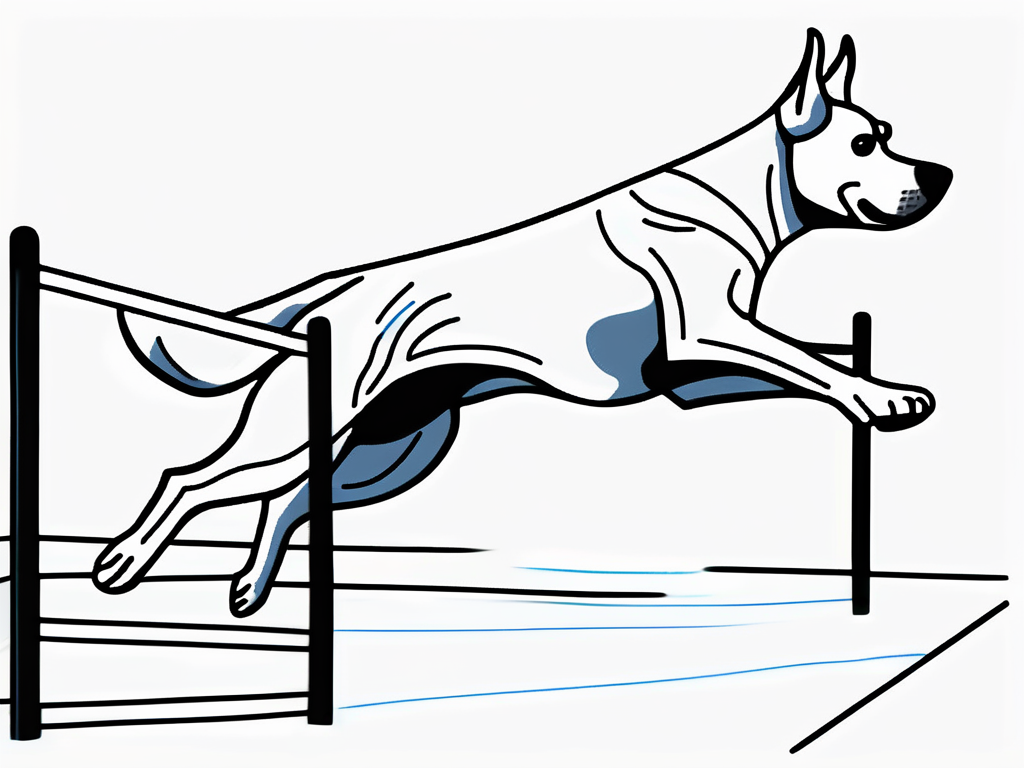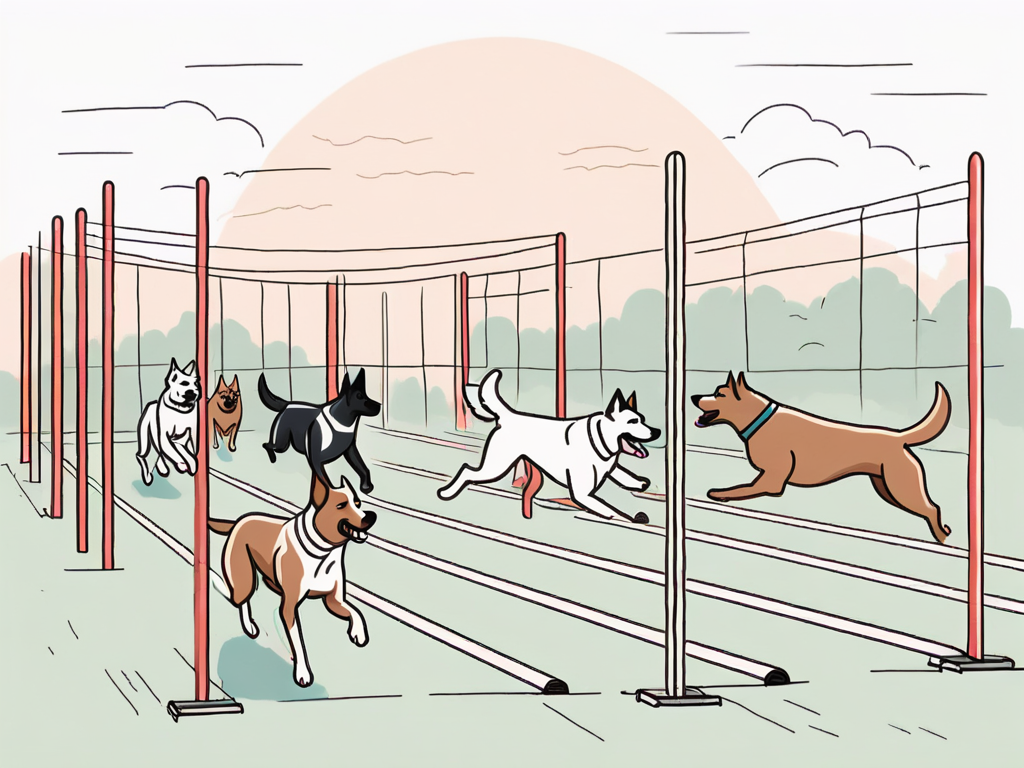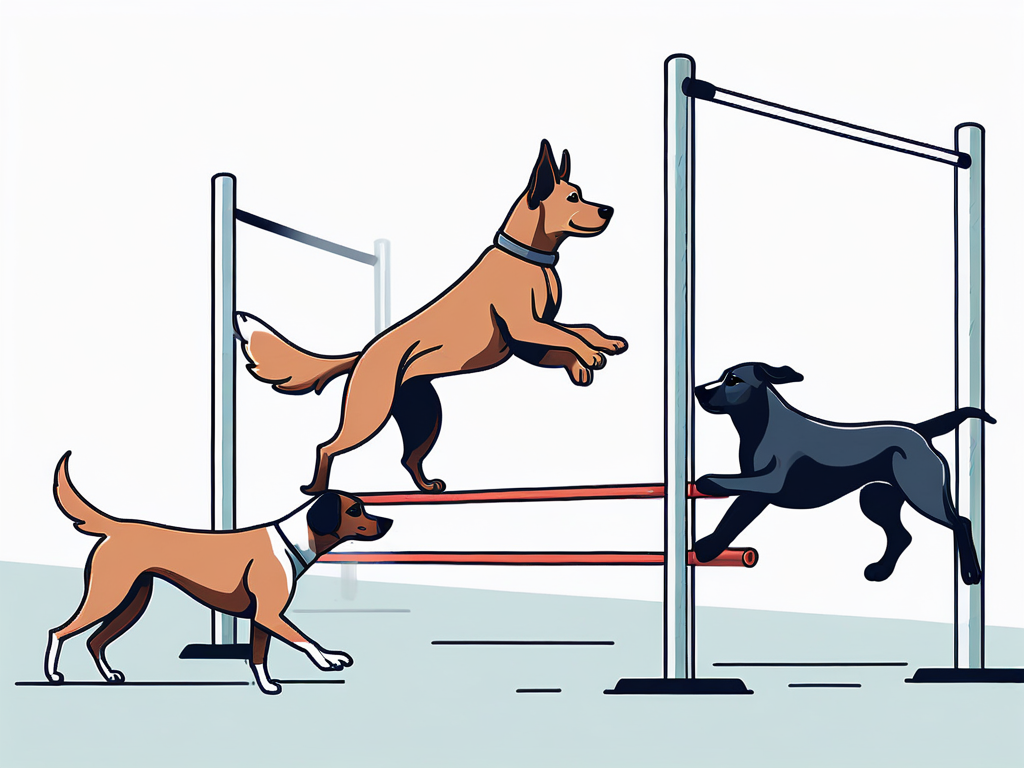The Ultimate Guide to Agility Training for Dogs

The Ultimate Guide to Agility Training for Dogs
Are you ready to unleash the inner athlete in your furry friend? Agility training is not only a fantastic way to keep your dog physically fit, but it also challenges their mind and strengthens the bond between the two of you. In this ultimate guide, we will explore all aspects of agility training, from the basics to overcoming common challenges. So, grab your pup's favorite toy and let's get started!
Understanding the Basics of Agility Training
Before diving headfirst into agility training, it's important to have a solid understanding of what it actually entails. Agility training is a dog sport that involves navigating through a series of obstacles, such as jumps, tunnels, weave poles, and A-frames, in a timed and controlled manner. It requires a combination of speed, precision, and teamwork between you and your dog.

What is Agility Training?
Agility training is like the canine equivalent of an obstacle course. Your dog will learn to jump over hurdles, weave through poles, dash through tunnels, and conquer teeter-totters like a champ. It's like a game of "doggy parkour" where your pup gets to showcase their athleticism and quick thinking.
Benefits of Agility Training for Dogs
Agility training offers a plethora of benefits for both you and your furry buddy. Not only does it provide physical exercise, which is essential for keeping them fit and healthy, but it also stimulates their mind and enhances their problem-solving abilities. Additionally, agility training can boost confidence, improve coordination, and deepen the bond between you and your furry friend through teamwork and trust.
Determining if Your Dog is Suitable for Agility Training
While agility training can be a great activity for most dogs, it's crucial to evaluate if your canine companion is a suitable candidate. Dogs of all shapes and sizes can participate in agility, but factors such as age, breed, and temperament should be considered. It's essential to consult with your veterinarian and observe your dog's enthusiasm for physical activities before embarking on agility training.
When it comes to age, it's important to note that puppies under the age of one are not recommended to participate in agility training. This is because their bones and joints are still developing, and the high-impact nature of agility can potentially cause injury. However, once your puppy reaches the appropriate age, you can gradually introduce them to agility training, starting with basic exercises and gradually increasing the difficulty level as they grow.
Breed is another factor to consider. While any breed can participate in agility training, certain breeds are naturally more inclined towards this sport. Border Collies, Australian Shepherds, and Shetland Sheepdogs, for example, are known for their agility and quick thinking, making them excellent candidates for this activity. However, this doesn't mean that other breeds can't excel in agility. With proper training and dedication, any dog can become an agility superstar!
Temperament plays a significant role in determining if your dog is suitable for agility training. Dogs that are highly energetic, eager to please, and enjoy problem-solving tend to thrive in this sport. However, dogs that are easily distracted, anxious, or have a low tolerance for frustration may find agility training overwhelming. It's important to assess your dog's personality and consult with a professional trainer to determine if agility training is a good fit for them.
Essential Equipment for Agility Training
Now that you understand the basics, let's dive into the equipment necessary for agility training. A well-equipped agility course will not only make training more enjoyable but also ensure your dog's safety.
Agility training is a thrilling activity that allows dogs to showcase their athleticism and intelligence. It provides mental and physical stimulation, helping to build a strong bond between you and your furry friend. To fully engage in this exciting endeavor, you'll need the right equipment.
Types of Agility Equipment
Agility equipment comes in a variety of forms, each designed to test different skills. Jumps and hurdles challenge your dog's jumping abilities, while tunnels and weave poles test their speed and agility. Contact obstacles, like A-frames and dogwalks, assess your pup's balance and coordination. To make training even more exciting, there's equipment like the pause table and tire jump that add a dash of flair to the course.
Imagine the thrill of watching your dog gracefully leap over a hurdle or swiftly maneuver through a tunnel. These equipment options provide a diverse range of challenges, ensuring that your dog's training sessions are never dull. It's like a canine obstacle course, where your pup can showcase their natural abilities and impress everyone with their agility skills.
Choosing the Right Equipment for Your Dog
When selecting agility equipment, it's important to consider your dog's size, age, and skill level. Opt for lightweight, adjustable equipment that can accommodate your dog's growth and progress. Safety should always be a priority, so invest in sturdy, well-built equipment that can withstand the rigors of training. Remember, your dog's comfort and enjoyment are key!
Every dog is unique, and their training needs may vary. Some dogs may excel at jumping, while others may prefer weaving through poles. By choosing the right equipment tailored to your dog's abilities, you can create a training course that challenges them just enough to keep them engaged and motivated.
Setting Up Your Agility Training Course
Now comes the exciting part: setting up your very own agility training course! Find a suitable space in your yard or a nearby park, ensuring it is safe and free from any potential hazards. Lay out your equipment, following recommended spacing and positioning guidelines. Keep the course challenging yet achievable for your dog, gradually increasing difficulty as their skills improve. And don't forget to add some colorful flags or ribbons to make it visually appealing!
As you set up the course, envision the incredible moments that await you and your dog. Picture the joy on their face as they conquer each obstacle, their tail wagging with pride. With a well-designed course, you can create a stimulating environment that encourages your dog to push their limits and reach new heights of agility.
Training Techniques for Agility
With the foundation in place, let's delve into the training techniques that will have your dog mastering the agility course with finesse.

Agility training is not just about physical prowess; it also requires mental acuity and a strong bond between you and your furry companion. By incorporating mental stimulation exercises into your training sessions, such as puzzle toys or scent games, you can enhance your dog's problem-solving skills and keep their mind sharp. This mental agility will translate into improved performance on the course, as your dog learns to think quickly and adapt to new challenges.
Basic Commands for Agility Training
Before tackling complex maneuvers, your dog needs a solid grasp of basic commands such as sit, stay, come, and heel. These commands serve as the building blocks for more advanced agility training. Consistent, positive reinforcement along with tasty treats and enthusiastic praise will make learning these commands a breeze.
Furthermore, incorporating hand signals along with verbal cues can provide additional clarity for your dog during agility training. Dogs are highly visual animals, and pairing hand signals with commands can help them better understand what is expected of them. This multi-sensory approach can improve communication between you and your dog, leading to smoother and more precise performances on the agility course.
Training Your Dog to Navigate Different Obstacles
Each obstacle in agility training comes with its own unique challenge. Start by introducing your dog to each obstacle individually, gradually building their confidence and mastering the technique. Utilize positive reinforcement and reward-based training to create a positive association with each obstacle. Soon enough, your dog will be acing jumps, weaving through poles, and conquering tunnels like a seasoned pro!
It's essential to vary the training environment to ensure that your dog can generalize their skills to different settings. Practice agility drills in various locations, such as parks, fields, or even indoor facilities, to help your dog adapt to different surfaces and surroundings. This versatility will make them more resilient and confident when faced with new courses or competition settings.
Improving Speed and Accuracy in Agility Training
As your dog's skills progress, it's time to focus on refining their speed and accuracy. Incorporate timed runs to encourage faster completion of the course, while paying attention to precise execution. Use rewards strategically to reinforce proper techniques and reinforce their desire to excel. Remember, practice makes perfect, so regular training sessions will yield fantastic results!
Additionally, incorporating interval training into your agility sessions can help improve your dog's cardiovascular endurance and overall fitness level. By alternating between periods of high-intensity activity and rest, you can boost your dog's stamina and speed, allowing them to maintain peak performance throughout an entire agility course. This physical conditioning will complement their technical skills, creating a well-rounded and competitive agility athlete.
Common Challenges in Agility Training
Even the best athletes face challenges, and agility training is no exception. Let's explore some common hurdles that you may encounter during your agility journey and how to overcome them.

Dealing with Fear or Anxiety in Dogs
Some dogs may initially feel timid or anxious when faced with new obstacles or training environments. Patience, gradual exposure, and positive reinforcement are key to helping your furry friend overcome these fears. Break down each obstacle into smaller steps, allowing your dog to progress at their own pace. With time and reassurance, they will build confidence and tackle challenges head-on.
Overcoming Training Plateaus
Training plateaus can be frustrating, but they are a natural part of the journey. If your dog seems to be stuck at a certain skill level, mix up your training routine. Introduce new obstacles or variations to keep things interesting and challenging. Additionally, seek guidance from experienced trainers or attend agility classes. These resources can provide fresh perspectives and help you overcome any training plateaus with your pup.
Addressing Behavioral Issues During Training
Sometimes, behavioral issues can arise during agility training, hindering progress. Whether it's excessive barking, overexcitement, or difficulty focusing, it's important to address these issues promptly. Seek guidance from professional trainers who can help you identify the underlying causes and provide tailored solutions. Remember, training should be a positive and enjoyable experience for both you and your dog!
With this ultimate guide as your roadmap, you're well on your way to embarking on an exciting agility training journey with your four-legged companion. Remember to have patience, celebrate small victories, and cherish the bond that agility training creates between you and your furry friend. Get ready to witness your pup's agility prowess as they conquer each obstacle with gusto. Happy training!


